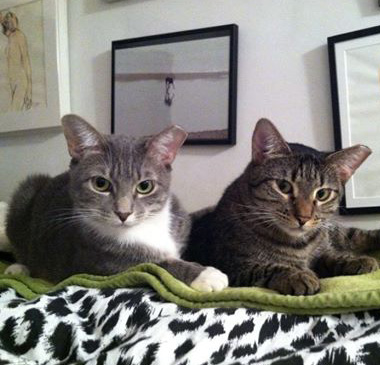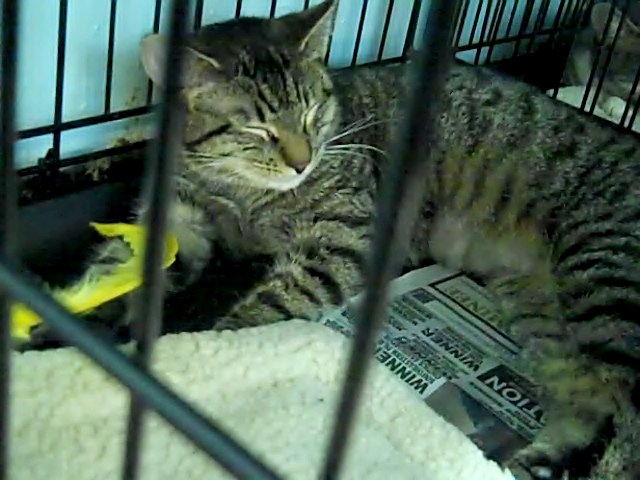
One of the most important concepts is to look at things from a cat's point of view. In this way, you will be more able to understand them, more able to troubleshoot little bumps along the road that occur, and more likely to make a strong connection with them. That understanding will foster a trusting and loving bond. With all the following techniques, we are looking to increase the cat's confidence and trust.
It is normal for shy cats to become more shy initially when they go into a new home,
as it is a big change for them, so don't be surprised if it takes them time to adjust. Just be
patient and consistent in gently working with them, and they will get more and more comfortable.
Keeping the cat in one small room is ideal. A bathroom can be a bit difficult to navigate for the humans, and a bit hard to socialize the cat in, so if you have a bedroom or other small room in which you can put a crate or playpen, that is generally easier to work with. Keep the cat or kitten in the playpen for a couple of weeks or more if they are very fearful, and then start gradually letting them out into the room a little at a time, so that he or she can become slowly acclimated to the apartment. If a bathroom. If you have them in a bathroom space initially and feel they are ready to explore a larger space like a bedroom after a week or so, that might be ok, but always err on the side of their comfort and feeling of safety. That way they will be less apt to hide.
NOTE: Letting a fearful/feral cat into a larger space too soon is the most common error people make when acclimating their cat to a home. This factor will affect the way the rest of your journey will go with the animal. I cannot stress enough the importance of this, and it is the reason why many cats are brought back to shelters because they are hiding, etc. If you do realize that you have done this too soon, get your cat back in the smaller space and keep them there for a while longer. That may be days, weeks or months, depending on the cat. Some people think that it will benefit the cat to have more space, when in reality, it is almost always most comfortable for a fearful cat to have a smaller, cozy space in the beginning, and to stay there until they are really at home there. And then, introduce the rest of the space to them gradually, perhaps bringing them into another room to play for a while, then back to their original cozy space, etc.
For a very fearful or feral cat, I recommend starting them in a large cage with wheels within a small room. This way, the cat can see everything around it, without being overwhelmed by actually being in that much new space at one time. It will also give you a better chance to make contact with the cat. Then, by the time you let them out, they will be much less apt to hide.
I started my two formerly-feral cats, Lulu and Natalia, in a large cage such as this:
https://www.chewy.com/midwest-
and
that can be the best way to start if your cat is not used to human
contact. Get one with wheels so you can move it to different parts of the apartment. I also recommend the mesh octagonal playpens. Those are not easy to move around, so that is the disadvantage, but the larger ones you can actually climb into from the top opening, so that can be helpful for socializing.
After they are at ease, and you are able to make some contact with them, you can slowly start to let them out of the crate or playpen. Then get them back in with food. Let them out for a longer period each day, then when they are comfortable, they can stay out of the crate. Keep the crate in the room until they are comfortable in the room. Slowly move the litter box and food out of the crate til they are eating and going in the box out of the crate.
Please contact me for more info on acclimating a feral cat to
your home. You will find my stories of acclimating my cats on my blog, http://sarahsuricat.blogspot.com. Search for "Natalia" to find the posts.
Don't rush these first steps, it will be worthwhile to take it even slower than you think you should. This comes from my first-hand experience, as well
as my experience with other shy and fearful shelter cats. Giving them plenty of time to adjust and feel safe in a smaller space will lay a
good foundation for them. A slow, gradual approach helps develop a deeply trusting, loving bond. For a feral or extremely feral cat, you will most likely need to take each of these steps even more slowly.
What you see as a small step can be a huge step for the cat. A good rule of thumb is to introduce each new thing to them slowly and gradually, breaking it down into steps if necessary.
You also need at least a couple of options that are not underneath furniture. This will encourage them to be more out and about, and will help them be more accessible to you.
A cat bed with sides could be a good idea, or even a small litter box with a small towel, baby blanket or soft pillow case inside. This helps the cat feel protected, without being totally hidden. Or something as simple as a cardboard box with a towel or something soft inside, so the cat can nestle inside but you can still see him or her. Paper shopping bags work well too - just make sure to cut the handles off so they don't get their heads caught in them. A carrier with a soft small towel etc inside can be an easy option and lets the cat get used to the carrier as a friendly space. A short tunnel (maybe about 20 inches long) can work well as a hidey spot.
https://www.amazon.com/
Scratch Lounges are great too. These are cardboard scratchers with raised sides that cats love to hang out in, and they feel rather protected.
https://www.chewy.com/scratch-
I recommend sitting quietly at a comfortable distance from the cat and doing a quiet activity like reading near them. Or if there are two people, you can have a quiet conversation near the cat. So that you are just casually spending time fairly close to the cat, without trying to approach it. And this is also something that is great to do before approaching the cat, so that you calm down your own energy before connecting with him/her.

TTouch is one of the techniques which I use with cats at the shelter and privately, and it is particularly helpful for shy cats. Following is my youtube channel:
The tools can be really helpful for shy cats. Tools are things such as feathers, paintbrushes, back scratchers and the like, which help give some space between you and the cat. It is a great way to help them get used to you touching them, and they may be less apt to run away from you if you start that way. These tools are also great for cats who tend to get overstimulated. The Air TTouches can work really well too for the really shy cats. I often do them with feral cats who are too afraid to be touched.
Temptations in the yellow package is a popular brand, as is original flavor Party Mix, and for a healthier option, chicken flavored Liv a Littles or other freeze-dried meat treats made for cats are great. Cat Man Doo bonito flakes are also popular. Fresh chicken or turkey is great too, but cut or break it into tiny pieces to use it as a treat to lure the kitty:)
At first, you can just toss a few treats near the cat to see if they will eat them in your presence. If they don't at first that is ok. The next step is putting the treats closer and closer to you. Then you can try putting the treat on the floor near you and put your hand next to the treat. Once that is accepted, you can put your hand on the floor with the treat in it, and see if the cat will eat off your hand. Again, take time with this. If the cat is hesitant to take it off your hand, take a step back and see if he will eat with your hand nearby. The next step is petting the cat as he takes the treat. As mentioned above, see the section on treats on my youtube channel for some ideas.
-Baby food: Most cats LOVE baby food (made for human babies) and it can be a really good way to get the cat to come to you. Remember to only use all-meat baby food, either Turkey or Chicken. Gerber's is the most universally liked, but Beechnut is even better to use if you can find it, as it does not have cornstarch in it, as Gerbers does. Make sure there are no onions or garlic in the ingredients in any case.
You can put a bit of the baby food on a spoon and let the cat lick it off. If necessary, you can use a spoon with a long handle, like those used for ice cream sodas. For example,
https://www.amazon.com/Hiware-9-Inch-Stainless-Cocktail-Stirring/dp/B01E3SS8AI/ref=sr_1_1?ie=UTF8&qid=1501384713&sr=8-1&keywords=ice+cream+soda+spoon
Once the cat will take the food from the spoon, start bringing the spoon closer to you. Once the cat will eat closer to you, see if he/she will lick it off your finger.
The Go Cat Cat Catcher is one of the most universally-liked cat toys, and I have seen it energize even a some very senior kitties who generally don't respond to toys:
https://www.amazon.com/Go-Cat-
(You can also buy replacement mice).
https://www.amazon.com/Cat-Dan
Da Bird is also a popular toy:
https://www.amazon.com/GoCat-Feather-Cat-Assorted-Colors/dp/B001BOVEU4/ref=sr_1_6?s=pet-supplies&ie=UTF8&qid=1501384942&sr=1-6&keywords=da+bird
-Bach Flower remedy. These are natural remedies that can help the cat to be more relaxed. See this page for instructions on using Rescue Remedy, which is something you can find at a health food store. I recommend the kind made for animals as it is not made with alcohol, but the regular kind is ok if you can't find it. Or contact me and I will make a custom remedy for your cat or cats.
-Quiet music. There are many choices to find nice quiet music, either you can find it on the radio, or on TV (I like the Soundscapes music channel, which also has an app available if you want to use your phone or a tablet etc), or online (iheart.com has a lot of options). This can be so soothing to the cats. Some cats enjoy listening to NPR (generally calm voices on those channels) or a classical music station, or possibly a jazz station if it stays on the calm side:)
For those not local to me, I can also do distant sessions with you over the phone the old-fashioned way, or through FaceTime. I am available to do distant Reiki sessions as well.
Contact me with any questions or feedback, etc, or to schedule a session. Fearful and feral cats have a special place in my heart, and I am always glad to be of help in whatever way I can:)